SUPER group presented during Coast Day (October 6, 2024) at Lewes, DE – where about 5000 members of the public come to learn about research being conducted at the University of Delaware. We presented data from a project funded by DE sea grant that focuses on studying development decisions in sensitive environmental areas in DE.

DOE Grants $2.5 Million for Pioneering Study on Energy Justice in US Offshore Wind Development, Led by the University of Rhode Island, Boston University, and the University of Delaware
Momentum is building for offshore wind in the United States with the country’s first large-scale project finally underway off the coast of Massachusetts and a growing number of projects in development, supported by billions of dollars in federal and industry investment. And now a $2.5 million grant from the US Department of Energy (DOE) is making it a national priority to understand the complex energy justice implications of this burgeoning renewable energy sector at its earliest stages.
With funding from DOE’s Wind Energy Technologies Office (WETO), the Boston University Institute for Global Sustainability (IGS), in collaboration with the University of Rhode Island and the University of Delaware, will identify energy justice indicators to measure the community effects of offshore wind energy development in the Northeastern US. Researchers will partner with environmental justice communities surrounding coastal ports that are poised to serve as regional hubs for the offshore wind sector on the East Coast. The team brings together experts in energy policy, environmental science, and community engagement to evaluate and monitor the potential impacts of this transition. From Boston University, research will be led by IGS Executive Director Rebecca Pearl-Martinez and IGS Director Benjamin Sovacool, professor in the Department of Earth & Environment.
Speaking to IGS’s aspirations for setting a new precedent in environmentally sound and socially equitable renewable energy development, Rebecca Pearl-Martinez, executive director of the Boston University Institute for Global Sustainability, said, “We’re excited to be partnering with community organizations and residents in the Northeast to identify and monitor the most pressing local issues related to offshore wind development. Co-producing this knowledge with communities aligns with our Institute’s emphasis on equity and justice in climate research. And what we learn will have relevance for offshore wind development throughout the country and globally.”
Key to the project’s approach is the involvement of port communities in New London, Connecticut, and New Bedford, Massachusetts, both considered important assets for supporting the future of offshore wind development in the region. Working with residents and community partners that include the NAACP New London Branch and the Old Bedford Village Development Corp. in New Bedford will provide invaluable insights about environmental justice concerns and how these projects influence local socio-economic dynamics. For three years, researchers will focus on conducting both qualitative and quantitative assessments of energy justice indicators to inform policy, shape industry practices, and empower communities to advocate for equitable outcomes—all to improve the overall quality of life for their residents.
The project’s Principal Investigator, David Bidwell, associate professor in the Department of Marine Affairs at the University of Rhode Island, provided further context. “Indicators give you a way to measure concepts that are difficult to define. But we don’t know what the indicators are for energy justice. What we know in the US is that ports are often surrounded by low-income or communities of color. And if you look at New Bedford or New London, you can definitely see those dynamics.”
A range of social indicators will be explored to fully capture the spectrum of energy justice impacts that offshore wind development can have, ensuring that community voices are influential in planning and implementation and that the benefits and burdens of the clean energy transition are distributed equitably. Economic indicators will play a significant role, examining aspects like job creation, job loss, and the safety of new roles that emerge, as well as the effects on local property values. Demographic indicators will shed light on how specific communities, especially those traditionally underrepresented or vulnerable, are affected. Attitudinal indicators will explore the perceived fairness of the outcomes of these developments. Procedural indicators will focus on the transparency and inclusivity of decision-making processes. Lastly, quality of life dimensions will be considered, encompassing factors like nuisances associated with construction, noise, air quality, and traffic.
“Wind energy is often discussed in terms of economic benefits. Our work will place communities affected by offshore wind development at the center of conversations on how to evaluate the benefits and costs of wind energy through the lens of fairness, equity, and justice,” added Nina David, associate professor, Biden School of Public Policy and Administration, University of Delaware.
This project, supported by President Biden’s Bipartisan Infrastructure Law, is among 15 across the country chosen by WETO for federal funding. It will help the DOE deliver on the Biden administration’s Justice 40 Initiative, which seeks to decrease energy burden, increase clean energy jobs and economic development, and build energy democracy in disadvantaged communities.
“Offshore wind power has become a vital tool for local and national climate action, and our research will be instrumental in ensuring its deployment is as equitable and just as possible,” said Benjamin Sovacool, director of the Boston University Institute for Global Sustainability.
About the Boston University Institute for Global Sustainability
The Boston University Institute for Global Sustainability (IGS) pioneers research to advance a sustainable and equitable future, convening faculty across the university’s diverse schools and colleges. Our focus on planetary and environmental health, climate governance and sustainability transitions, and energy systems of the future is grounded in equity and justice, robust data science, and real-world impact. To learn more, visit bu.edu/igs.
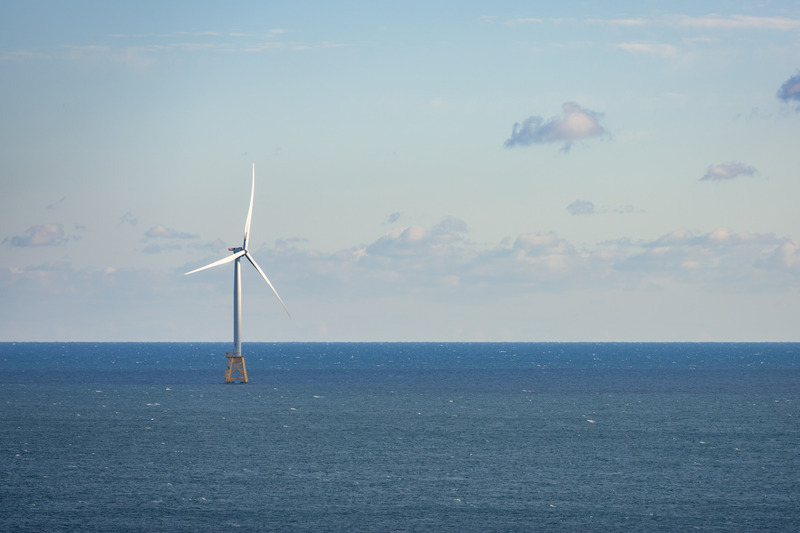
Jeremy Firestone, professor in UD’s School of Marine Science and Policy, and Nina David, associate professor in UD’s Joseph R. Biden Jr., School of Public Policy and Administration and the director of the Energy and Environmental Policy Program, are part of a multi-institutional team of researchers looking at how coastal communities perceive offshore wind in order to better understand their concerns, preferences and values.
OFFSHORE WIND ENERGY GRANTS
Article by Adam Thomas Photo by Evan Krape December 13, 2023
Two grants featuring UD faculty look to better assess community impacts of offshore wind development
As the United States grapples with how to best integrate offshore wind facilities into future energy plans, gauging how those coastal communities perceive offshore wind is going to be critical in order to better understand their concerns, preferences and values. Two separate grants totaling $5 million from the United States Department of Energy will look to do just that, with the studies getting input from residents on both the east and west coasts of the United States.
These projects include the University of Delaware. The two UD faculty members involved are Jeremy Firestone, professor in UD’s School of Marine Science and Policy, who is involved in both of the projects, and Nina David, associate professor in UD’s Joseph R. Biden Jr., School of Public Policy and Administrationand the director of the Energy and Environmental Policy Program, who is working on the URI-led project.
The east coast project is led by researchers at the University of Rhode Island (URI) and will look to develop social impact markers to help the researchers and the local communities measure the effects of offshore wind energy development. The project will focus on three cities undergoing port redevelopment: London, Connecticut; New Bedford, Massachusetts; and a third to be determined at a future date.
The west coast research project is led by Oregon State University (OSU), and the aim is to interview and survey coastal residents to understand their preferences in areas where offshore wind development has been proposed. As the federal government is in the early stages of leasing areas off the coast of Oregon, California and Maine for floating offshore wind energy projects, one of the ideas advanced has been to encourage project developers to establish agreements with coastal communities about specific community benefits those companies would provide.
Currently, UD’s portion of the funding is $686,122 for the URI project and $264,591 for the OSU project.
David said it is imperative to figure out how offshore wind energy projects will impact the communities that live nearby.
“The promise of offshore wind energy development is significant. But how those benefits accrue, to whom, and in what time period is less understood,” she said. “What is exciting about this project is that we will partner with stakeholder communities to co-produce the indicators that will provide the empirical evidence on the justice and equity impacts of offshore wind.”
Firestone echoed these sentiments, saying that the development of offshore wind power will play an important role in U.S. climate action.
“It also will displace emissions otherwise experienced by communities adjacent to fossil fuel generation plants,” he said. “However, equity also requires consideration of fairness in decision-making and in the allocation of costs and benefits to communities on land and at sea that may be affected by offshore wind power.”
With a background in architecture, environmental science and urban and regional planning, David said a significant component of her work could be described as “engaged scholarship” where the goal is to co-produce knowledge with stakeholders so that the research has a direct impact on the ground.
“I will be working on the surveys and other data collection instruments for this project, but an important role will be to use my background in engaged research to help the project team facilitate community engagement in developing the energy justice indicators that we will track over time,” David said.
Firestone said having two projects on both coasts will help the researchers better determine community preferences from a diverse group of stakeholders.
“The OSU-led research will engage communities adjacent to proposed offshore wind projects in California, Oregon, Washington, and Maine, each of which is much more rural than those adjacent to advanced-planned projects on the east coast,” Firestone said. “It will be an important advance as we know much less about how rural communities perceive offshore wind power, let alone their perceptions of just decision-making processes and outcomes compared to the more urbanized, beach economy communities we have on much of the east coast.”
More information about the projects can be found on the University of Rhode Island website and the Oregon State University website.
https://www.udel.edu/udaily/2023/december/delaware-offshore-wind-energy-turbine-green-fossil-fuels/
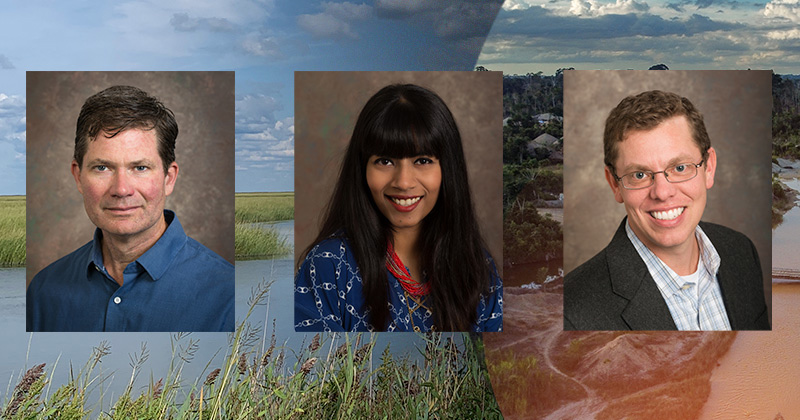
The Delaware Environmental Institute (DENIN) has selected three UD professors — from left to right, Kent Messer, Nina David and Jon Cox — to be 2023-25 Faculty Fellows.
EXPANDING DENIN’S REACH
Article by Karen B. Roberts Photos by Evan Krape, Karen B. Roberts and courtesy of Therany Gonzales and Nina David | Photo illustration by Jeffrey C. Chase April 21, 2023
Delaware Environmental Institute announces 2023-25 Faculty Fellows
Editor’s note: The University of Delaware is joining the more than 1 billion people, governments, institutions, and businesses who participate in Earth Day — Saturday, April 22 — to recognize our collective responsibility and to help accelerate the transition to a brighter, greener, and more equitable future for generations to come.
The Delaware Environmental Institute (DENIN) at the University of Delaware has worked for nearly 15 years to safeguard the environment by advancing interdisciplinary research, knowledge and solutions to environmental issues. DENIN also is a source for interdisciplinary environmental expertise and a training ground for future environmental leaders.
Now, DENIN has selected three UD professors — Jon Cox, Nina David and Kent Messer — to augment this effort as 2023-25 Faculty Fellows.
During the two-year appointment, Cox, David and Messer will lead initiatives to expand environmental research, enhance public understanding of environmental issues and connect with community stakeholders.
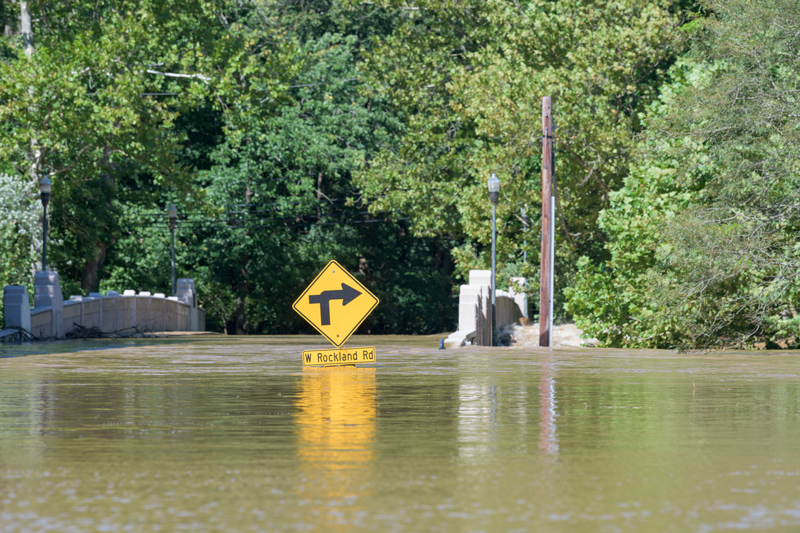
Extreme weather events, such as torrential rain storms, are a consequence of climate change that can lead to flooding in urbanized areas.
The program is an extension of DENIN Director Holly Michael’s vision for expanding the institute’s reach across campus and in the community by engaging faculty in ways that reflect their interests, while growing DENIN in multiple directions.
“Jon, Nina and Kent bring diverse talents and new dimensions to DENIN,” said Michael. “Their work will reverberate across the broader environmental community, and we are thrilled to have the opportunity to work more closely with them.”
Faculty fellows receive $15,000 per year in financial support to explore research, community or policy solutions to environmental problems. They also gain access to logistical expertise within DENIN. Read below to learn more about their individual projects.
DENIN Faculty Fellows 2023-25
Jon Cox is an associate professor of art and design and a committed environmentalist. A community-engaged scholar, Cox’s research focuses on connecting people and passions through community partnerships. For instance, his work with the Maijuna Indigenous community in the Amazon in Peru led to new insights about the community’s trade and farming practices that informed Delaware educatorsbuilding lesson plans for teaching about the Amazon.
As a DENIN Faculty Fellow, Cox plans to connect art, environmental conditions and community through the lens of mining. He is planning an interdisciplinary multimedia experience (photos, films, speakers, etc.) bridging art and science to address climate and environmental justice issues by amplifying the voices of Indigenous and underrepresented communities impacted by extraction. Open to the public, the exhibit will be offered in English and Spanish, in cooperation with University Library, Museums and Press. It will include express opportunities for students and teachers at K-12 schools in Delaware to engage with the artwork, artists and film screenings.
“I hope this multimedia experience will be a catalyst for others to learn more about the mining industry and arrive at creative solutions to mitigate the environmental injustices in communities directly impacted by extraction,” said Cox.
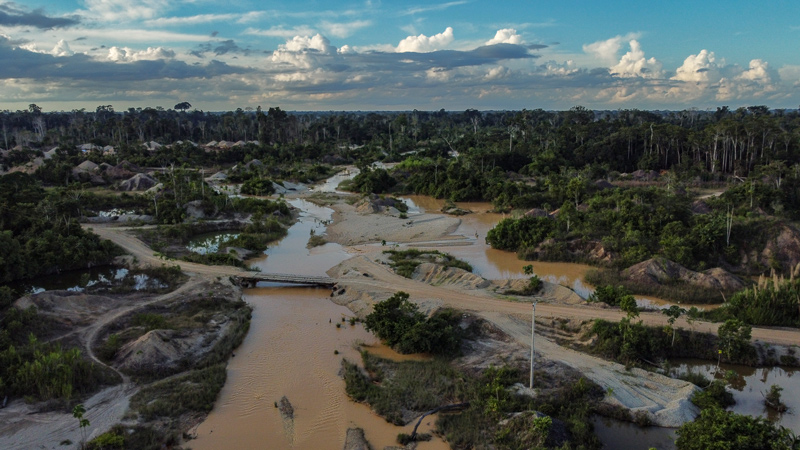
Mining pits like those shown here in the Madre de Dios region of Peru were rainforests not long ago. Many Indigenous communities in remote regions of Amazonia are heavily impacted by illegal gold mining and other extraction practices. These mining practices result in a multitude of problems, from the loss of ancestral lands and biodiversity to environmental mercury poisoning with human impacts, child sex trafficking, animal poaching, climate change, ecosystem loss and more. DENIN Faculty Fellow Jon Cox is creating a multimedia experience to shine a light on these climate and environmental justice issues and those affected.
Nina David, associate professor and director of the energy and environmental policy programs in the Joseph R. Biden, Jr. School of Public Policy and Administration, has a background in urban planning, architecture and environmental science. She is planning to create a DENIN Communities of Practice initiative that will connect policymakers, community stakeholders and UD researchers to foster engaged scholarship that can impact policymaking and directly respond to problems identified by communities on the ground. This will involve assessing the needs of faculty, staff and other external stakeholders to explore what interests and University-community collaborations already exist, with an eye for where additional groups could be formed or fostered across research, teaching and service to forge a robust and self-sustaining infrastructure around environmental research.
“As scholars, we all want to produce work that has an impact and, increasingly, granting agencies are recognizing and prioritizing scholarship that responds to stakeholder needs,” said David. “The goal of this initiative is to create engaged research opportunities in the deepest sense. This means laying a foundation and facilitating collaborations that can lead to long-term systematic partnerships with stakeholders rather than entering into one-off agreements right when requests for proposals (RFPs) for grants requiring community collaborations come along.”
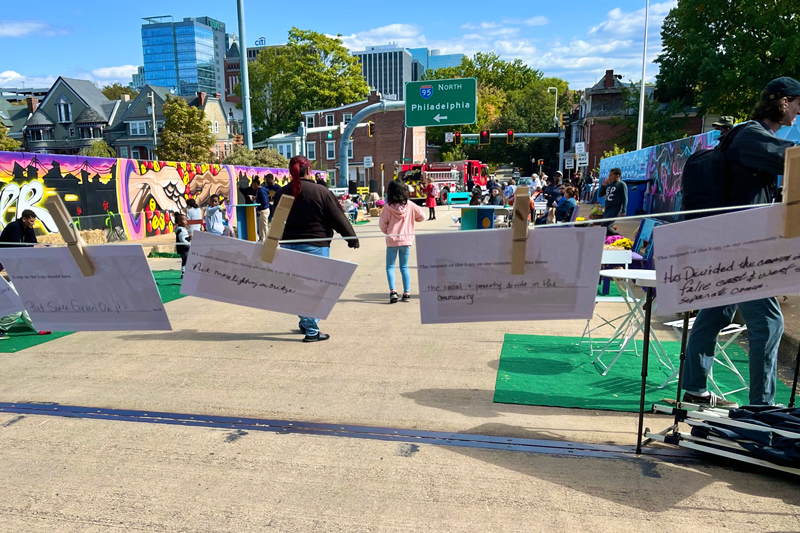
In fall 2022, DENIN Faculty Fellow Nina David and her research team co-sponsored an event to help Wilmington residents envision proposed changes to a multilane highway that separates the east and west sides of the city that would cap the six-block stretch with green space. This type of community engagement is a hallmark of David’s work.
Kent Messer, S. Hallock du Pont Professor of Applied Economics and director of the Center for Experimental and Applied Economics, is a behavioral economist specializing in land and environmental conservation, among other things. Messer will focus on expanding foundation-funded work at DENIN centered on a wide array of environmental issues. Some areas of interest for DENIN include coastal processes that interact with climate change, sea level rise and coastal resilience, and solutions to per-and polyfluoroalkyl substances (PFAS), the forever chemicals found in items, such as firefighting foam, plastic coatings, shampoos, among other things, that show up in soils, well water and other areas of the environment and are historically difficult to break down. Through these and other efforts, Messer hopes to help enhance DENIN’s global reputation for environmental research and partnership, while offering rich opportunities for student engagement in research.
“DENIN is well position to expand its reach and impact. I am thrilled to be working with the leadership of DENIN to help amplify the environmental research and solution development at the University of Delaware,” said Messer.
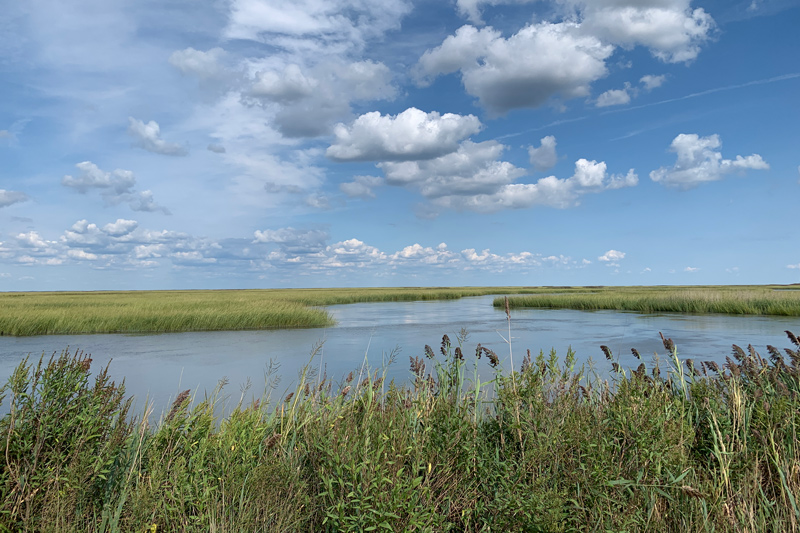
Bombay Hook National Wildlife Refuge is a protected area that safeguards one of the largest remaining expanses of tidal salt marsh in the mid-Atlantic region. As a DENIN Faculty Fellow, Kent Messer hopes to expand foundation-funded work with the potential to preserve and protect our environment for decades to come.
THE IMPACT OF HIGHWAY CONSTRUCTION

With support from a Partnerships for Arts and Culture Grant, Nina David, associate professor in UD’s Biden School, and her research team co-sponsored an event on Oct. 8 in which they closed off the 9th Street bridge in Wilmington to allow residents to gather over the highway and envision what a potential capping of I-95 could look like.
Article by Amy Wolf Photos courtesy of Nina David December 09, 2022
UD’s Nina David examines impact of I-95 construction in Wilmington
Today, it’s hard to imagine Interstate 95, which runs straight through the heart of Wilmington, in any other location. But in the 1950s, there were three possible routes for the major highway: a western route along Bancroft Parkway, an eastern route where I-495 runs today, and a central route that cuts straight through the city along the Adams-Jackson corridor.
After the Federal-Aid Highway Act of 1956 was passed, which meant that 90% of the cost of highway construction would be funded by the federal government, a highway in Delaware’s largest city went from being just an idea to a real possibility. In the spring of 1957, four public hearings were held on the location of the freeway. Much of the focus was on the western route, so it came as a surprise when, on June 21, 1957, the lame duck Wilmington City Council approved the Adams-Jackson corridor seemingly out of the blue.
“That particular decision was, I would say, from everything that we can see in the research, a pretty sudden decision,” said Nina David, associate professor in the University of Delaware’s Joseph R. Biden, Jr. School of Public Policy and Administration, who is conducting research on the construction of I-95 through Wilmington and its impact on the surrounding communities. “There was no public process on that particular alignment, and the impact of it was pretty huge, because it was 25 city blocks. That’s a big swath of a very dense urban core in the city. There were 926 families that were displaced as a result, so it’s a considerable amount of people that were moved out of that core section of the city. It had a considerable impact, but with very little public process.”
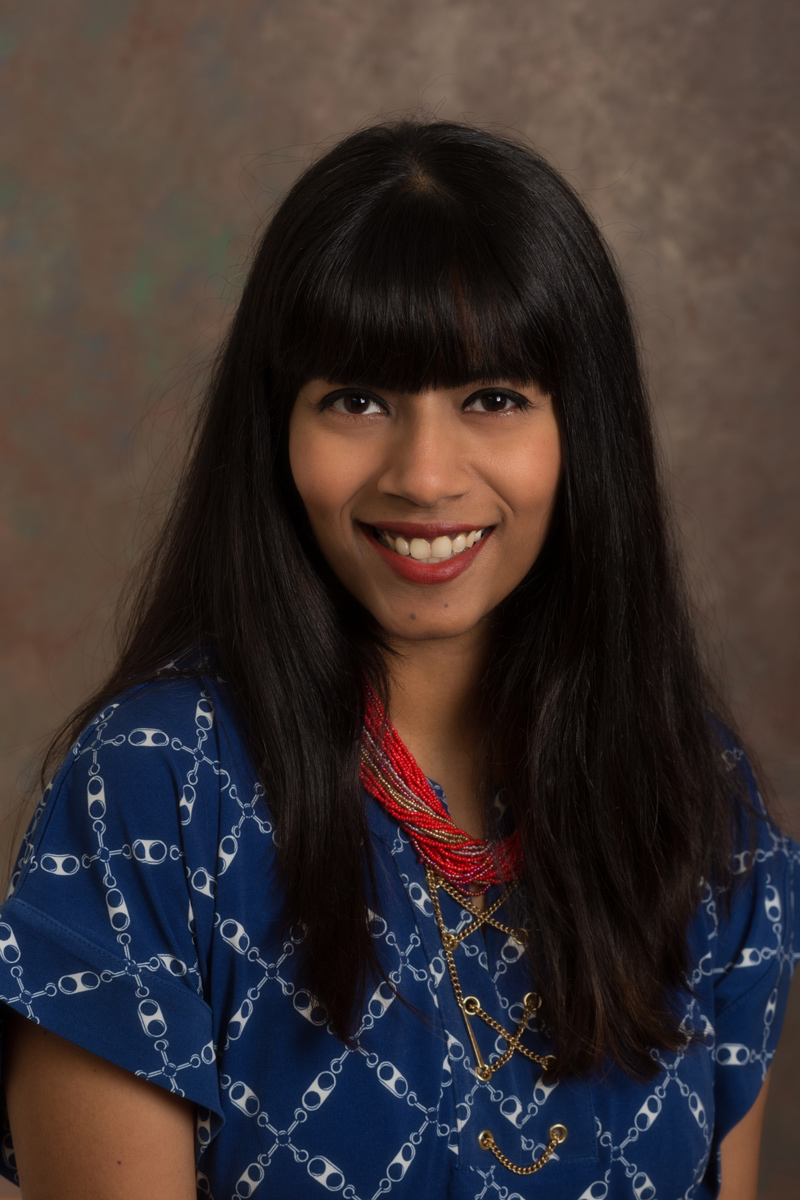
Associate Professor Nina David
David’s research examines the Adams-Jackson corridor to document what was there before the highway, discern the policy decisions that led to I-95 being routed through the corridor and understand what might have been lost through the process, including the built environment (streets, buildings and landmarks), people (who lived and worked there), community (life and culture in the corridor and nearby neighborhoods), and institutions (churches and schools). The archival research includes content analyses of the plans, policy documents, reports and summaries of public hearings; analyses of newspaper articles published at the time; rephotography of the area; and interviews with residents from the corridor.
In all, 507 residential dwellings, 50 commercial structures, 48 garages, two churches, one public school, one private school and one theater were demolished — and 926 families displaced — to make way for the highway.
“We are conducting interviews with residents that we could track, of families, that lived in that space to get the stories of what the community was like prior to the 95 coming through, because right now, when you look at that space, it’s difficult to imagine what it used to be like,” David said. “For a lot of people, the highway has been there for over 60 years, and that’s within their lifetime. That generation of the folks who lived in that space, this is sort of the end of a generation, so we wanted to capture the stories before they are lost.”
David has been working on research for two years, and the project has received a lot of public attention. She and her students were invited to have a conversation with Rep. Lisa Blunt Rochester, Sen. Tom Carper and some members of the Delaware state legislature in the summer of 2021 to talk about the research. In partnership with the Delaware Historical Society, David hosted a virtual lecture and participated in a panel discussion regarding the research, of which hundreds of community members attended.
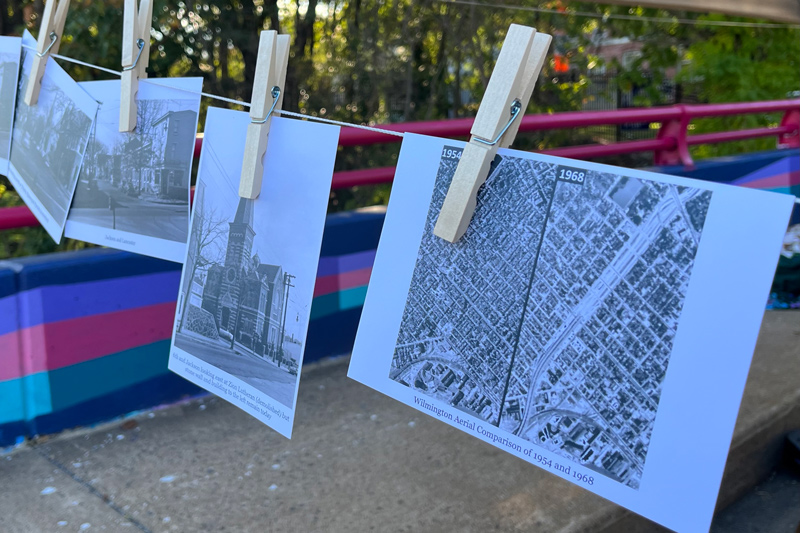
Historical photographs help to show the impact of I-95 along the Adams-Jackson corridor, where the highway was constructed in Wilmington beginning in the late 1950s.
One of the biggest impacts of the construction of the highway was the division created between the east and west sides of the city. With the passage of the Infrastructure Investment and Jobs Act in 2021, there is great interest all around to “cap” the highway to create better connections between the east and west sides, David said. Indeed, local transportation agencies, such as WILMAPCO and DelDot, are working on feasibility studies to do exactly that.
But capping the highway — taking a six-block stretch of the multilane highway and covering it with greenspace — can be hard to imagine. With support from a Partnerships for Arts and Culture Grant, David’s research team co-sponsored an event on Oct. 8 in which they closed off the 9th Street bridge in Wilmington to allow residents to gather over the highway and envision what a potential capping of I-95 could look like.
“If you watch shows like on HGTV, it’s very difficult for people to go into a blank space and imagine how it could be different,” David said. “The same occurs in the urban built environment as well. It’s hard to envision what [a cap] would look like. To actually stand there, though, on top of the 9th Street bridge, look on either side at the 95 and imagine that you were not going to be able to see the 95 anymore — that’s what we’re talking about. So it was an event to come to experience what having that pedestrian space over the 95 could actually look and feel like.”
At the event, David facilitated public dialogue on the impact of highways on communities and collected data through an I-95 impact survey. The results of the survey will be passed on to policymakers in addition to being published in academic venues.
COMMUNITY ENGAGEMENT
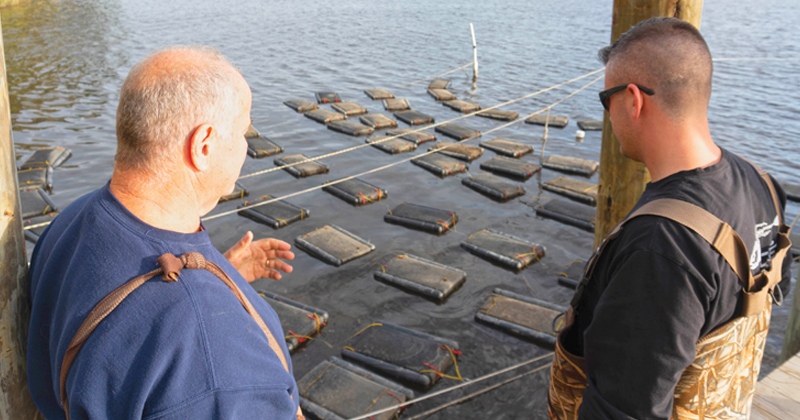
Delaware Sea Grant (DESG), which is housed within the University of Delaware’s College of Earth, Ocean and Environment, helps Delaware communities wisely use, manage and conserve the state’s coastal resources. DESG fisheries, aquaculture and seafood specialist Ed Hale, right, advises a local oyster farmer tending to a cage-based aquaculture set-up in the Indian River Bay.
Article by UDaily staff Photo by Mark Jolly-Van Bodegraven March 28, 2023
Committee works to highlight UD’s engaged scholarship and collaborative partnership outcomes
The University of Delaware’s Carnegie Foundation community engagement reclassification application process began with the creation of a steering committee in February. The first Carnegie Foundation classification was in 2015. That process was led by Lynnette Young Overby, Director of the Community Engagement Initiative (CEI). Since then, many faculty and students have collaborated with CEI to create impactful partnerships and engaged scholarship opportunities.
UD engaged scholars, such as associate professor of art and design Jon Cox, who partners with the Maijuna Indigenous community in the Amazon in Peru, connect people and passions through community engagement partnerships. Last summer, the Maijuna Indigenous community shared its trade and farming practices with the Delaware Teachers Institute. In turn, Cox and his cohort of educators from across Delaware gained insight into how best to teach about the Amazon by experiencing it firsthand. Delaware teachers learned about land rights, sustainability, and the impact of logging and climate change from the Maijuna community.
Over the years, Cox has taught multiple students who have benefited from the learning opportunities provided through the Community Engagement Initiative (CEI). He suggests students who are interested in community engagement apply to be a community engagement scholar or a community engaged summer scholar. Cox recommends that faculty contact the Community Engagement Initiative to access their network and resources. He noted, “I would recommend reaching out to the Community Engagement Initiative. There is a lot of support out there. You can meet other people; you do not have to do it alone or reinvent the wheel.”
Learn more about other engaged scholarship work taking place at UD:
UD’s Nina David examines impact of I-95 construction in Wilmington
UD professor Carla Guerrón Montero brings anthropology to daily life so students can thrive
Partnership for Healthy Communities receives contract award for Community Wellbeing Initiative
The University of Delaware was originally classified as a Carnegie Foundation for the Advancement of Teaching Elective Classification for Community Engagement designated campus in 2015. After years of providing local, state, regional, national and global community engagement partnerships, it is time for UD to renew its Carnegie community engagement classification. The reclassification process and self-study, rooted in recent community engagement outcomes and impact, are now underway thanks to the steering committee’s leadership. The final application is due in April 2025.
Defining Community Engagement
The Carnegie Foundation for the Advancement of Teaching defines community engagement as a “collaboration between institutions of higher education and their larger communities (local, regional/state, national, global) for the mutually beneficial exchange of knowledge and resources in a context of partnership and reciprocity. The purpose of community engagement is the partnership of college and university knowledge and resources with those of the public and private sectors to enrich scholarship, research and creative activity; enhance curriculum, teaching and learning; prepare educated, engaged citizens; strengthen democratic values and civic responsibility; address critical societal issues; and contribute to the public good.”
This framework guides community engagement outcomes and impacts at UD. The steering committee for reclassification is led by Matthew Robinson, deputy director of the Community Engagement Initiative. Robinson noted, “The application process offers the University the opportunity to assess who we are, how we have advanced since our last application, and where we need to go to fulfill our potential as an engaged university. Earning reclassification is an important indication that the University of Delaware is committed to community engagement.”
The steering committee will work with the UD community and community partners to gather data, outcomes and impact details that will be incorporated into the application process. A mechanism for sharing community engagement will be announced after the working groups have been announced.
Provost Laura Carlson noted, “I believe that the biggest and best ideas come from bringing together partners across disciplines, arenas, communities and continents. Community engagement at UD invites students, faculty researchers and community partners to spend time sharing, researching and, most importantly, thinking together. The Carnegie reclassification application provides UD an excellent opportunity to thoughtfully reflect, assess and expand what community engagement looks like at UD and what it could be in the future.”
Members of the steering committee include: Leann Moore, associate director, Community Engagement Initiative; Suzanne Burton, associate dean for the arts and professor of music education in the College of Arts and Sciences; Michael Vaughn, vice provost for Equity; Steve Peuquet, professor emeritus of the Joseph R. Biden, Jr. School of Public Policy and Administration; Nancy Getchall, professor of kinesiology and physiology and professor of women and gender studies and current Faculty Senate president; Michelle Rodgers, associate dean and director of Cooperative Extension and Outreach; Alison Karpyn, co-director for Center for Research in Education and Social Policy (CRESP) and associate professor in the Department of the Human Development and Family Sciences; Heather Kelly, director of Institutional Research and commissioner of Middle States Commission on Higher Education; Matthew Creasy, associate director for leadership development for University Student Centers, Division of Student Life; and Haley Q. Burns, assistant policy scientist for the Joseph R. Biden, Jr. School of Public Policy and Administration.
Two additional members, who serve in leadership positions with community partners, will join the steering committee.
Fourth Annual Provost’s Symposium
Learn more about community engagement at UD and at other institutions of higher education in Delaware by attending the fourth annual Provost’s Symposium on “The State of Delaware’s Higher Education Institutions: Convening to Promote and Develop Sustainable and Impactful Community Partnerships,” which will be held from 9 a.m.-3:30 p.m., Thursday, April 20, in the Audion at the Tower at STAR at the University of Delaware.
The symposium brings together faculty, professional staff and students from UD, Delaware State University, Wilmington University, Delaware Technical Community College and Goldey-Beacom College to discuss their respective institution’s role and the collective roles of higher education’s community engagement impact in Delaware.
The program will include:
each institution’s definition of community engagement, promotion and impact;
panel discussions with engaged scholars and community partners; and
focus on community partners’ needs to ensure sustainable and impactful partnerships.
Registration is required for the in-person symposium. Livestream will be available for select sessions. Registration is not required for livestream.
For more information about the Carnegie reclassification application and the Community Engagement Initiative, contact Matthew Robinson, mjrobins@udel.edu.
EXPLORING THE INTERSECTION OF COMMUNITIES AND TECHNOLOGY
Photo by Kathy F. Atkinson April 07, 2020
New research center brings together experts in sociotechnical systems
https://www.udel.edu/udaily/2020/april/sociotechnical-systems-center/
DATA BOOST TO BATTLE FLOODS
Photo by Lisa Tossey June 03, 2020
UD team partners with national research group dedicated to addressing America’s flood risk
https://www.udel.edu/udaily/2020/june/flood-research-data-coastal-retreat-first-street-foundation/
BETTER BLOCK PROJECT RESULTS IN PERMANENT PHYSICAL CHANGES TO UNION STREET IN WILMINGTON, DE
Dr. Nina David wins 2016 Excellence in Downtown Revitalization Award for the Better Block Project in Wilmington
West Side Grows Together recognizes the University of Delaware’s School of Public Policy and Administration and Nina David, Assistant Professor and a resident of Wilmington’s West Side, for bringing the Better Block Project to N. Union St. in Wilmington, DE.
The Better Block Project is a demonstration tool that temporarily transforms an area based to demonstrate what a walkable neighborhood center could look and feel like, to actively engage communities in the design and decision-making process, and to show the potential for revitalized economic activity.
Held over three days in August for the last two years, Better Block has attracted more than 500 people to Union St. to see the power that traffic calming, outdoor seating, and diagonal parking can have on a place. It has helped build community consensus around neighborhood improvements, including reducing N. Union St. to two lanes of traffic and building a more pedestrian-friendly and attractive business district.
Cornerstone West CDC with Dr. David’s assistance leveraged the broad public support we have built around infrastructure improvements to successfully advocate for the City of Wilmington to prioritize N. Union St. in its transportation infrastructure improvements process.
In 2017, the City of Wilmington re-striped N. Union St. and implemented several of the ideas from the Better Block event.
Here is other coverage of the event.
http://www.udel.edu/udaily/2015/aug/better-block-081414.html


